Partnerships Black WidowElektra | Species Human Mutate | |
 | ||
Alter ego Matthew Michael "Matt" Murdock Played by Movies and TV shows Similar | ||
Daredevil is a fictional superhero appearing in American comic books published by Marvel Comics. Daredevil was created by writer-editor Stan Lee and artist Bill Everett, with an unspecified amount of input from Jack Kirby. The character first appeared in Daredevil #1 (April 1964).
Contents
- 1960s
- 1970s
- 1980s
- 1990s
- 2000s
- 2010s
- Powers and abilities
- Other versions
- Reception
- Supporting characters
- Daredevil enemies
- Live action
- Animation
- Film
- Video games
- Toys
- References
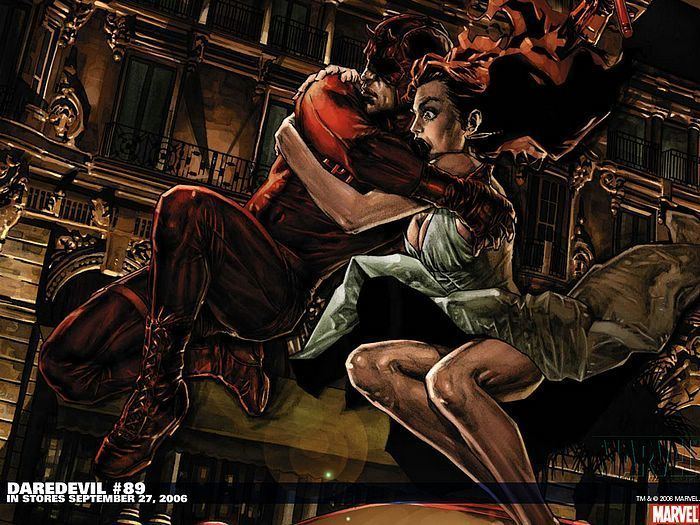
Daredevil's origin story relates that while living in the historically gritty or crime-ridden, working class Irish-American neighborhood of Hell's Kitchen in New York City, Matt Murdock is blinded by a radioactive substance that falls from an oncoming vehicle while pushing a man to safety from the oncoming truck. While he no longer can see, the radioactive exposure heightens his remaining senses beyond normal human ability and gives him a "radar sense". His father, a boxer named Jack Murdock, supports him as he grows up, though Jack is later killed by gangsters after refusing to throw a fight. After donning a yellow and dark red costume (later all dark red), Matt seeks out revenge against his father's killers as the superhero Daredevil, fighting against his many enemies, including Bullseye and Kingpin. He also becomes a lawyer. Daredevil is also commonly known by such epithets as the Man Without Fear and the Devil of Hell's Kitchen.
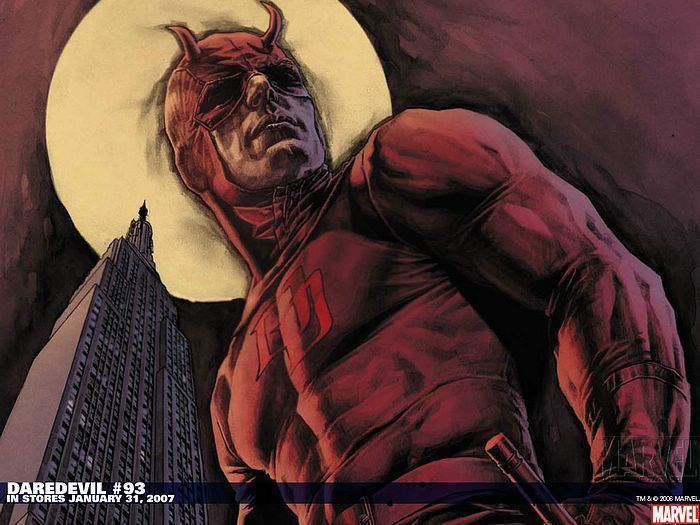
Frank Miller's influential tenure on the title in the early 1980s cemented the character as a popular and influential part of the Marvel Universe. Daredevil has since appeared in various forms of media including several animated series, video games and merchandise, and the 2003 feature-length film Daredevil, where he was portrayed by Ben Affleck. Charlie Cox portrays Daredevil in Marvel's Daredevil, a live-action television series on Netflix that premiered on April 10, 2015, and is set to reprise his role in The Defenders, as part of the Marvel Cinematic Universe.
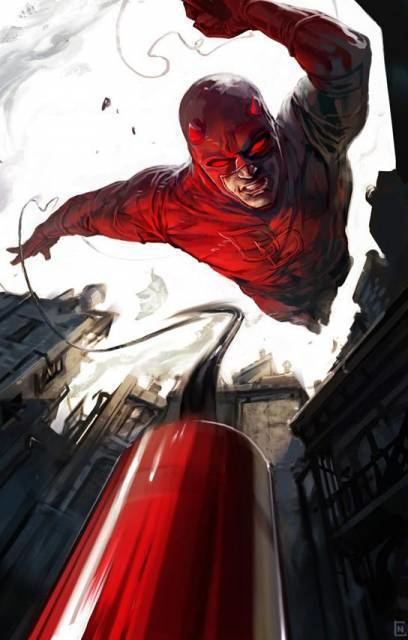
1960s
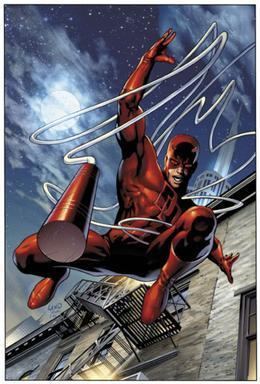
The character debuted in Marvel Comics' Daredevil #1 (cover date April 1964), created by writer-editor Stan Lee and artist Bill Everett, with character design input from Jack Kirby, who devised Daredevil's billy club.

Writer and comics historian Mark Evanier has suggested without confirmation that Kirby also designed the basic image of Daredevil's initial costume, though Everett modified it. That original costume design was a combination of black, yellow, and red, reminiscent of acrobat tights. Wally Wood introduced Daredevil's modern red costume in issue #7 in which Daredevil's battle against the far physically superior Sub-Mariner has become one of the most iconic stories of the series.

The series' 31-issue run by writer-editor Stan Lee and penciler Gene Colan includes Daredevil #47, in which Murdock defends a blind Vietnam veteran against a frameup; Lee has cited it as one of his favorite stories of his career.
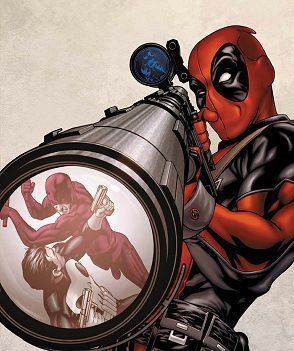
The first issue covered both the character's origins and his desire for justice on the man who had killed his father, boxer "Battling Jack" Murdock, who raised young Matthew Murdock in the Hell's Kitchen neighborhood of Manhattan, New York City. Jack instills in Matt the importance of education and nonviolence with the aim of seeing his son become a better man than himself. In the course of saving a blind man from the path of an oncoming truck, Matt is blinded by a radioactive substance that falls from the vehicle. The radioactive exposure heightens his remaining senses beyond normal human thresholds, enabling him to detect the shape and location of objects around him. In order to support his son, Jack Murdock returns to boxing under the Fixer, a known gangster, and the only man willing to contract the aging boxer. When he refuses to throw a fight because his son is in the audience, he is killed by one of the Fixer's men. Having promised his father not to use physical force to deal with things, Matt gets around that promise by adopting a new identity who can use physical force. Adorned in a yellow and black costume made from his father's boxing robes and using his superhuman abilities, Matt confronts the killers as the superhero Daredevil, unintentionally causing the Fixer to have a fatal heart attack.
Daredevil would embark on a series of adventures involving such villains as the Owl, Stilt-Man, the Gladiator, and the Enforcers. In issue #16 (May 1966), he meets Spider-Man, a character who would later be one of his greatest hero friends. A letter from Spider-Man unintentionally exposed Daredevil's secret identity, compelling him to adopt a third identity as his twin brother Mike Murdock, whose carefree, wisecracking personality much more closely resembled that of the Daredevil guise than the stern, studious, and emotionally withdrawn Matt Murdock did. The "Mike Murdock" scheme was used to highlight the character's quasi-multiple personality disorder (he at one point wonders whether Matt or Mike/Daredevil "is the real me"), but it proved confusing to readers and was dropped in issues #41–42, with Daredevil faking Mike Murdock's death and claiming he had trained a replacement Daredevil. Murdock reveals his secret identity to his girlfriend Karen Page in issue #57, although she leaves the series after the revelation proves too much for her. This was the first of several long-term breakups between Murdock and Page, who would prove the most enduring of his love interests.
1970s
Gerry Conway took over as writer with issue #72, and turned the series in a pulp science fiction direction: a lengthy story arc centered on a robot from thousands of years in the future trying to change his timeline, and even long-standing arch-villain the Owl was outfitted with futuristic weaponry and vehicles. He also moved Daredevil to San Francisco beginning with Daredevil #86, and simultaneously brought on the Black Widow as co-star. The Black Widow served as Daredevil's co-star and love interest from #81–124 (Nov. 1971–Aug. 1975), of which #93-108 were cover titled Daredevil and the Black Widow.
Jann Wenner, the co-founder and publisher of the Rolling Stone music magazine appeared in Daredevil #100 (June 1973) by Gerber and Colan.
The writing and editing jobs went to Marv Wolfman with issue #124, which wrote the Black Widow out of the series and returned Daredevil to Hell's Kitchen. Wolfman promptly introduced the lively but emotionally fragile Heather Glenn to replace the Black Widow as Daredevil's love interest. Wolfman's 20-issue run included the introduction of one of Daredevil's most popular villains, Bullseye, and a story arc in which the Jester uses computer-generated images to hoodwink the mass media.
With issue #144, Jim Shooter became the writer and introduced Paladin in issue #150 (Jan. 1978). Shooter had difficulty keeping up with the schedule, and the writing chores were shortly turned over to Roger McKenzie.
McKenzie's work on Daredevil reflected his background in horror comics, and the stories and even the character himself took on a much darker tone: Daredevil battled a personification of death, one of his archenemies was bifurcated by a tombstone, and a re-envisioning of Daredevil's origin showed him using stalker tactics to drive the Fixer to his fatal heart attack. McKenzie created chain-smoking Daily Bugle reporter Ben Urich, who deduces Daredevil's secret identity over the course of issues #153–163, and had Daredevil using the criminal underworld of Hell's Kitchen as an information network, adding several small-time crooks to the supporting cast.
Halfway through his run, McKenzie was joined by penciler Frank Miller with issue #158 (May 1979).
In a story arc overlapping Wolfman, Shooter, and McKenzie's runs on the series, Daredevil reveals his identity to Glenn and becomes partially responsible for the suicide of her father; their relationship would persist, but would prove increasingly harmful to both of them. Though the Black Widow returned for a dozen issues (#155–166) and attempted to rekindle her romance with Daredevil, he ultimately rejects her in favor of Glenn.
1980s
Miller disliked Roger McKenzie's scripts, so new editor Denny O'Neil fired McKenzie so that Miller could write the series.
Miller continued the title in a similar vein to McKenzie. Resuming the drastic metamorphosis the previous writer had begun, Miller took the step of essentially ignoring all of Daredevil's continuity prior to his run on the series; on the occasions where older villains and supporting cast were used, their characterizations and history with Daredevil were reworked or overwritten. Most prominently, dedicated and loving father Jack Murdock was reimagined as a drunkard who physically abused his son Matt, entirely revising Daredevil's reasons for becoming a lawyer. Spider-Man villain Kingpin was introduced as Daredevil's new nemesis, displacing most of his large rogues gallery. Daredevil himself was gradually developed into an antihero. In issue #181 (April 1982), he attempts to murder one of his arch-enemies by throwing him off a tall building; when the villain survives as a quadriplegic, he breaks into his hospital room and tries to scare him to death by playing a two-man variation on Russian roulette with a secretly unloaded gun.
Miller introduced ninjas into the Daredevil canon, bringing a martial arts aspect to Daredevil's fighting skills, and introducing previously unseen characters who had played a major part in his youth: Stick, leader of the ninja clan the Chaste, who had been Murdock's sensei after he was blinded; a rival clan called the Hand; and Elektra, an ex-girlfriend turned lethal ninja assassin. This was a drastic change for a character once called "the sightless swashbuckler". Elektra was killed fighting Bullseye in issue #181 (April 1982).
After #191 Miller left the series entirely. O'Neil switched from editor to writer. He continued McKenzie and Miller's noir take on the series, but backed away from the antihero depiction of the character by having him not only spare Bullseye's life, but express guilt over his two previous attempts to kill him. Miller returned as the title's regular writer, co-writing #226 with O'Neil. Miller and artist David Mazzucchelli crafted the acclaimed "Daredevil: Born Again" storyline in #227–233. In the Born Again storyline Karen Page returns as a heroin-addicted porn star, and sells Daredevil's secret identity for drug money. The Kingpin acquires the information and in an act of revenge, orchestrates a frameup which costs Murdock his attorney's license. Miller ended the arc on a positive note, with Murdock reuniting with both Karen Page and Maggie, the mother he thought dead, now a nun.
Ann Nocenti later became the series's longest-running regular writer, with a four-and-a-quarter-year run from #238–291 (Jan. 1987 – April 1991).
The team returned Murdock to law by co-founding with Page a nonprofit drug and legal clinic, while Nocenti crafted stories confronting feminism, drug abuse, nuclear proliferation, and animal rights-inspired terrorism. She introduced the antagonist Typhoid Mary, and in issues #262–265 used the Inferno event as a backdrop for the collapse of Daredevil's life: the clinic is destroyed, Page goes missing after learning of his affair with Mary Walker, and Walker reveals herself as the alter ego of Typhoid Mary. Murdock subsequently becomes a drifter in upstate New York, an especially controversial move in Nocenti's run, as it marked the first time the character had been taken outside of an urban environment. She ended her run with a positive turn in Murdock's fortunes: he returns to Hell's Kitchen, regains his sense of self, reconciles with Foggy Nelson, and resolves to seek out Karen Page.
1990s
New writer D. G. Chichester continued from where Nocenti left off, with Murdock resuming his friendship with Foggy Nelson, struggling to re-win the heart of Karen Page, appealing the revocation of his attorney's license, and bonding more deeply than ever with Hell's Kitchen. Chichester's focus on Daredevil's relationship with New York City went so far as to have two issues devoted entirely to Daredevil defending New Yorkers from ordinary criminals and even simple accidents. The critically acclaimed "Last Rites" arc from #297–300 saw Daredevil regaining his attorney's license and finally bringing the Kingpin to justice.
Frank Miller returned to the character and his origins with the 1993 five-issue Daredevil: The Man Without Fear miniseries. With artist John Romita Jr., Miller expanded his retcon of the life and death of Murdock's father, "Battling Jack" Murdock, and Murdock's first encounters with the Kingpin and Foggy Nelson. The role of Stick in the genesis of Daredevil was expanded, as was Murdock's doomed love affair with Elektra.
The creative team of Chichester and penciler Scott McDaniel changed the status quo with their "Fall From Grace" storyline in issues #319–325 (Aug. 1993 – Feb. 1994). Elektra, who was resurrected in #190 but had not been seen since, finally returned. An injured Daredevil creates a more protective costume from biomimetic materials: red and gray with white armor on the shoulders and knee pads. Revamped billy clubs could attach to form nunchucks or a bo staff. His secret identity becomes public knowledge, leading to him faking his own death and assuming the new identity of "Jack Batlin". This new identity and costume lasts for several story arcs, while Murdock finds a way to convince the world that he is not, in fact, secretly Daredevil (courtesy of a double). A short stint by J. M. DeMatteis returned Daredevil to his traditional red costume and Matt Murdock identity.
Under writers Karl Kesel and later Joe Kelly, the title gained a lighter tone, with Daredevil returning to the lighthearted, wisecracking hero depicted by earlier writers. Matt and Foggy (who now knows of Matt's dual identities) join a law firm run by Foggy's mother, Rosalind Sharpe.
In 1998, Daredevil's numbering was rebooted, with the title "canceled" with issue #380 and revived a month later as part of the Marvel Knights imprint. Joe Quesada drew the new series, written by filmmaker Kevin Smith. Its first story arc, "Guardian Devil", depicts Daredevil struggling to protect a child whom he is told could either be the Messiah or the Anti-Christ. Murdock experiences a crisis of faith exacerbated by the discovery that Karen Page has AIDS (later revealed to be a hoax) and her subsequent death at Bullseye's hands. When he discovers that the true party responsible for the scheme is Mysterio currently dying of cancer, he leaves Mysterio to commit suicide, deciding to use the money Karen left him in her will to re-open Nelson & Murdock.
Smith was succeeded by writer-artist David Mack, who contributed the seven-issue "Parts of a Hole" (vol. 2, #9–15). The arc introduced Maya Lopez, also known as Echo, a deaf martial artist.
2000s
David Mack brought colleague Brian Michael Bendis to Marvel to co-write the following arc, "Wake Up" in vol. 2, #16–19 (May 2001 – August 2001), which follows reporter Ben Urich as he investigates the aftereffects of a fight between Daredevil and the new Leap-Frog.
The 2001 Daredevil: Yellow miniseries presented another take on Daredevil's origins using letters written to Karen Page after her death. The series depicts the early rivalry between Matt Murdock and Foggy Nelson for Page's affection, and incorporates many events depicted in the earliest issues of Daredevil. The supervillains the Owl and the Purple Man appear as antagonists. In this story, Daredevil credits Page with coining the phrase "The Man Without Fear", and she suggests to Daredevil he wear all maroon instead of dark red and yellow.
Issue #26 (December 2001) brought back Brian Michael Bendis. Developments in this run included the introduction of romantic interest and future wife Milla Donovan, the outing once again of Murdock's secret identity, the reemergence of the Kingpin, and Daredevil's surrender to the FBI.
The impact of his exposure as Daredevil continued to be used as a plot point by both Bendis and writer Ed Brubaker and artist Michael Lark, who became the new creative team with Daredevil vol. 2, #82 (Feb. 2006).
Brubaker's first story arc had a new character masquerading as Daredevil in Hell's Kitchen. Murdock later discovered the ersatz Daredevil is his friend Danny Rand, the superhero Iron Fist.
The series returned to its original numbering with issue #500 (Oct. 2009), which followed vol. 2, #119 (Aug. 2009). New writer Andy Diggle revised the status quo, with Daredevil assuming leadership of the ninja army the Hand. Daredevil later appeared in the one-shot Dark Reign: The List – Daredevil.
2010s
Following this came the crossover story arc "Shadowland", in which Daredevil is possessed by a demon. Murdock then leaves New York, leaving his territory in the hands of the Black Panther in the briefly retitled series' Black Panther: Man Without Fear #513. Murdock finds himself renewed in the miniseries Daredevil: Reborn #1–4 (March–July 2011).
In July 2011, Daredevil relaunched with vol. 3, #1 (Sept. 2011), with writer Mark Waid. Waid focused on emphasizing the character's powers and perception of the physical world. In the premiere issue, Murdock finds he can no longer serve as a trial lawyer due to past allegations of his being Daredevil causing a case he represents in court to turn into a media circus. Two issues later, Nelson and Murdock have developed a new business strategy of serving as consulting counselors, by teaching clients how to represent themselves in court. Daredevil joins the New Avengers in a story written by former Daredevil series writer Brian Michael Bendis. Daredevil appeared as a regular character in the 2010–2013 New Avengers series in issues #16–34 (November 2011 – January 2013). At one point, Foggy begins to question Matt's sanity, ultimately leading to a fallout between the two. They reconcile once the truth is discovered. Daredevil vol. 3 ended at issue #36 in February 2014, in which Matt is forced to publicly reveal his Daredevil identity, resulting in his being disbarred by New York and prompting him to again relocate to San Francisco.
Waid and Chris Samnee followed this up with Infinite Comics' Daredevil: Road Warrior weekly digital miniseries, which focused on an adventure during Matt's trip to San Francisco. It was reprinted as issue 0.1 in Daredevil volume 4, which launched under Waid and Samnee with a new issue #1 (March 2014) as part of the All-New Marvel NOW! storyline centered on Matt's new life in San Francisco.
Daredevil volume 4 ended with issue #18 in September 2015. A new volume began as part of the All-New, All-Different Marvel branding, written by Charles Soule with art by Ron Garney with the first two issues released in December 2015. In this series, Matt returns to New York, where he now works as an Assistant District Attorney. He will have a redesigned costume and a new apprentice in Samuel Chung, an illegal immigrant who has been living in New York's Chinatown since he was a child, who has taken up the codename Blindspot. Also due to a method Matt used which had not yet been disclosed, he has somehow caused for the world to forget he is Daredevil, with Foggy being the only exception, enabling him to be re-instated as a New York Attorney. In a meeting with Spider-Man, Daredevil confirmed that he had full control of the process that wiped his civilian name from everyone's memory when Spider-Man asked him why there were gaps in his recollection of their past experiences, sharing the general details with Spider-Man to confirm that he trusts his friend.
Powers and abilities
Although the character is blind, his remaining four senses function with superhuman accuracy and sensitivity, giving him abilities far beyond the limits of a sighted person. Few characters know that the hero cannot see. Daredevil developed a radar sense, which is similar to echolocation. Writer/co-creator Stan Lee said that he was worried that blind people would be offended at how far he exaggerated the way a blind person's remaining senses are enhanced, but that his fears were assuaged by letters from organizations such as The Lighthouse for the Blind which said that blind people greatly enjoyed having Daredevil comics read to them.
The Beyonder once restored Daredevil's eyesight, but, suspecting a trick on Beyonder's part, Daredevil immediately insisted that his blindness be restored. Beuonder reluctantly agreed.
When Frank Miller expanded most of Daredevil's abilities, he attempted to make them "extraordinary enough to be exciting, but not on par with Superman", noting Superman's distinctly unbelievable powers. When Miller joined the title in 1979, the first thing he did to the character was "revamp" his radar sense and made it less distinct and more believable; he wanted Daredevil to have the "proximity" sense that some martial artists claim to have. Due to the character's sensitive sense of touch, Daredevil can read by passing his fingers over the letters on a page though laminated pages prevent him from reading the ink. Daredevil has commonly used his superhuman hearing to serve as a polygraph for interrogation by listening for changes in a person's heartbeat. This ability can be fooled if the other person's heart is not beating at a natural rate, such as if they have an artificial pacemaker.
Just as Daredevil's other senses are stronger, they are also sensitive; his main weakness is his vulnerability to powerful sounds or odors that can temporarily weaken his radar sense. This weakness is often used to immobilize Daredevil. Alternately, the lack of taste or smell can be used against him, as in one instance of a hallucinogenic drug so designed so that Daredevil could not tell he was drugged. His senses are highly acute, capable of sensing the minor atmospheric disturbance created moments before a teleporting character appears.
While his radar sense mostly compensates for his blindness, it has certain limitations. He cannot perceive color without touch, and he can only read printed matter if the ink is raised enough for his sense of touch. Most photographs, televisions, and computer screens are blank to him. However, the radar sense has shown on numerous occasions the ability to see through walls and fabrics. The radar sense also grants him an omnidirectional field of vision. These two latter abilities are the most notable advantages the radar has over normal vision.
Though he has no superhuman physical attributes beyond an enhanced sense of balance, Daredevil is a master of martial arts. Having been trained by Stick, Daredevil is a master hand-to-hand combatant. His typical moves are unique blends of the martial arts of Ninjutsu, Aiki Jūjutsu, Jujitsu, Kung Fu, Silat, Capoeira, Judo, Aikido, Wrestling, and Stick Fighting combined with American-style Boxing while making full use of his gymnastics capabilities.
Daredevil's signature weapon is his specially designed baton, which he created. Disguised as a blind man's cane in civilian garb, it is a multi-purpose weapon and tool that contains 30 feet of aircraft-control cable connected to a case-hardened steel grappling hook. Internal mechanisms allow the cable to be neatly wound and unwound, while a powerful spring launches the grapnel. The handle can be straightened for use when throwing. The club can be split into two parts, one of which is a fighting baton, the other of which ends in a curved hook.
In his civilian identity, Murdock is a skilled and respected New York attorney. He is a skilled detective, tracker, and interrogation expert, as well as being an expert marksman.
Other versions
In addition to his mainstream incarnation, Daredevil has been depicted in other fictional universes, including Marvel 2099, Marvel Noir and the Ultimate Marvel Universe.
Reception
Daredevil was named Empire's 37th Greatest Comic Book Character, citing him as "a compelling, layered and visually striking character". Wizard magazine ranked Daredevil 21st among their list of the 200 Greatest Comic Characters of All Time, and comic book readers polled through the website Comic Book Resources voted the character the third best of the Marvel Comics stable. IGN in 2011 ranked Daredevil as #10 on their list of "Top 100 Comic Book Heroes".
Supporting characters
Throughout the core Daredevil series, many characters have had an influence in Matt Murdock's life. His father, "Battlin' Jack" Murdock instills in Matt the importance of education and nonviolence with the aim of seeing his son become a better man than himself. He always encouraged Matt to study, rather than fight like him. Jack forbade his son from undertaking any kind of physical training. It is his father's murder that prompts the super-powered character to become a superhero, fighting gangsters. He was trained by an old blind ninja master named Stick following his childhood accident.
Matt Murdock's closest friend is Franklin "Foggy" Nelson, his college roommate, sidekick, and law partner. Their relationship in the early years of the series was fraught with tension due to Nelson's sense of inferiority to Murdock as a lawyer and as a target for the affections of their secretary, Karen Page. They frequently argued over Murdock's preference for defending supervillains, as Nelson's enthusiasm is for corporate law. The pudgy and fallible Nelson has often been used by writers for lightheartedness and even comic relief. As a superhero, one of Daredevil's best friends is the hero Spider-Man; with his enhanced senses, Murdock was able to physically identify Spider-Man on their first meeting, and Spider-Man in turn learned his secret identity some time after. Due to the events of the "One More Day" storyline, Murdock no longer knows Spider-Man's secret identity, and since then refused to relearn it due to the potential danger involved. Iron Fist would later become one of his greatest friends, and at one point took on the role of Daredevil himself. Jessica Jones, a former superhero turned private investigator acts as a bodyguard for Matt Murdock in his civilian life. Her husband, Luke Cage, is a friend of Daredevil as well. Maya Lopez, a deaf woman and skilled martial artist, is a friend of Daredevil after he fought her and convinced her that he did not murder her father, because she was being manipulated by the Kingpin, who was responsible. Ben Urich, a reporter for the Daily Bugle discovered Daredevil's identity and eventually becomes his friend as well, though during his identity dispute Daredevil decided to end his "secret professional relationship" with Urich to avoid getting Urich mixed up in his problems and being used against him. The Punisher, anti-hero Frank Castle, is one of Daredevil's reluctant allies, as well as his antagonist due to their different philosophies in crime fighting.
Daredevil has a convoluted and often tortured love life. One of Daredevil's more notable love interests is Elektra, an assassin who would later be killed. In the 2000s, Murdock marries a woman named Milla Donovan, although one of Daredevil's enemies drives her to insanity.
Daredevil enemies
In his early years, Daredevil fought a number of costumed supervillains, the first of these being Electro, a prominent Spider-Man foe, in Daredevil #2. A number of recurring villains would be introduced over the years, such as the Owl, the Purple Man, Mr. Fear, Stilt-Man, Gladiator, the Jester, the Man-Bull, and Death-Stalker. The supervillain duo of the Cobra and Mr. Hyde have frequently clashed with Daredevil, and Hyde has fought Daredevil alone on several occasions. The psychotic assassin Bullseye was introduced by Marv Wolfman in issue #131, and was a frequent antagonist over the next six years of the series.
Beginning with Frank Miller's run on Daredevil, his traditional rogues gallery was used less often, and The Kingpin became Daredevil's arch-enemy. Like the Purple Man, Death-Stalker, Assassin, and several others, the Kingpin has long known Daredevil's secret identity. His run as the series's central villain ended with issue #300, but he continues to menace Daredevil on occasion. Elektra made her debut as a bounty hunter, and though her time as part of Daredevil's rogues gallery was brief (spanning barely a year of the series), her romantic past with him is an important part of the mythos. In Daredevil #254, Ann Nocenti introduced Typhoid Mary, an assassin for the Kingpin with an identity disorder, who would become a prominent Daredevil foe.
